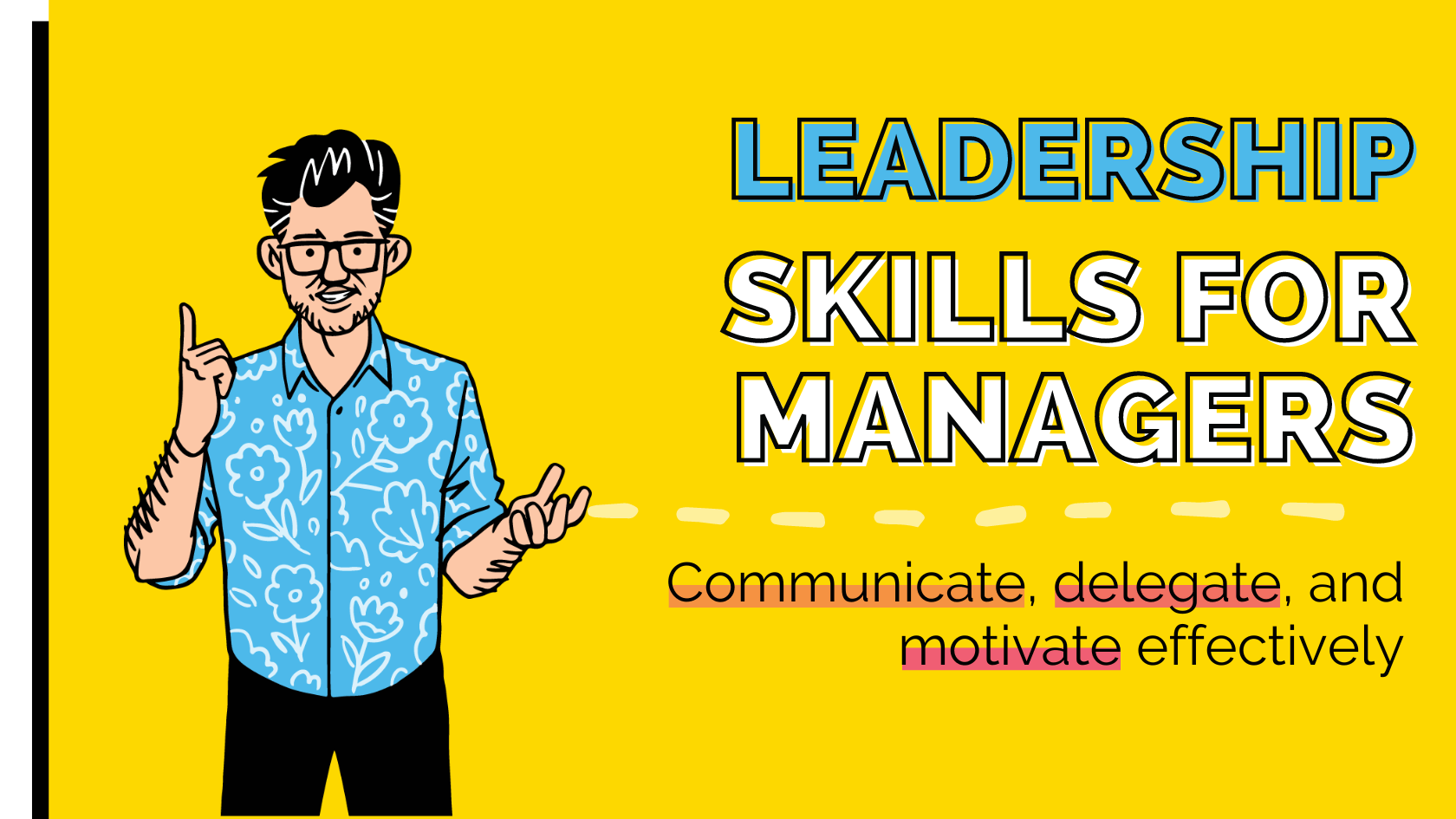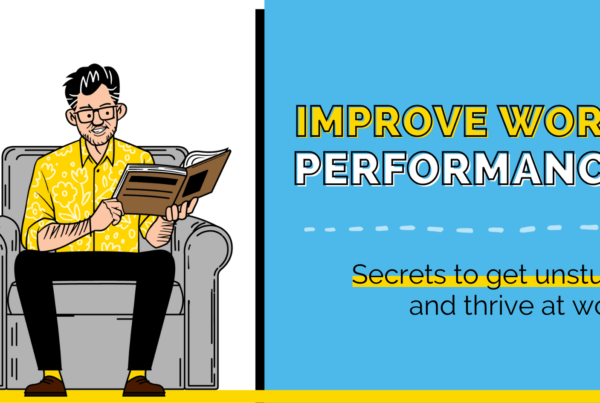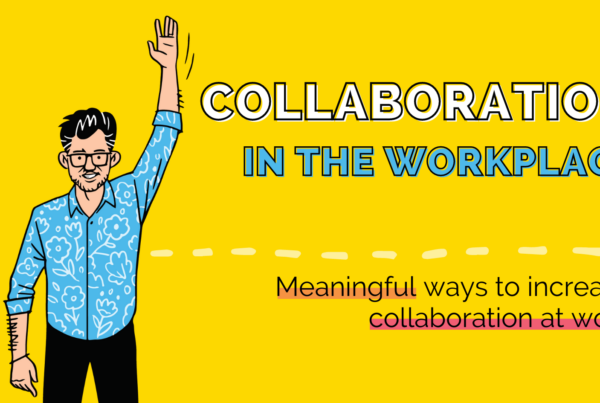
“Amazing. Awesome.” I can almost hear you thinking. “Once I work my way through this list of skills, I’ll surely become a great leader.”
If only it was as simple as that. No doubt, mastering these leadership skills in a single bound would indeed make you a better manager… but this isn’t like plugging in your phone for a system upgrade.
So before we plunge in, pause for a moment.
Often when we’re presented with a list of things to do, we forget to see or acknowledge the opportunity cost. We forget that every choice we make means we’re saying yes to this one thing and no to another.
Put simply – you can’t have everything.
With that in mind, I recommend approaching this list by trying to answer the question: “Which skill might solve the most significant challenge for me?”
What is going to help you make a greater impact? Which will help you build better working relationships? What should you be doing to unlock your own and your team’s greatness?
The answers to these questions will guide you towards adopting skills that are genuinely helpful for you and your team, rather than overwhelming yourself with every single competency shared across all the Fortune 500 CEOs.
Let’s jump in!
The Greatest Answers Come From the Greatest Questions
Become a better leader. Better teacher. Better person.
Learn how to ask the right questions the right way with this free download.
Eight Ways to Ask a Question Well
1. Communicate What Matters
George Bernard Shaw lays out the problem with panache: “The single biggest problem with communication is the illusion that it has taken place.”
Way too often, managers think communicating involves sharing their nuggets of wisdom or delegating tasks. But, actually, the way to communicate better is to simply amp up your curiosity.
Think of it this way. Whenever you tell someone what to do, you steal a little bit of their autonomy and zap their creativity. They don’t feel empowered or motivated or excited – and innovation suffers.
When you engage with others through thoughtful questions and slow down the rush to give advice, you help people generate their own answers.
Result? Everybody wins. You spend less time putting out fires as a manager and your team’s competencies soars.
Here are three of my favorite questions to get you started:
- What do you already know to be true?
- How would you answer your own question?
- What needs to be said that hasn’t yet been said?
2. Solve the Real Problem
Great problem-solving is all about solving the real problem, the meta-problem, the problem behind the problem – not just the problem being presented to you.
After all, there are a million problems out there, waiting to be solved. As a manager, the best way to help your team unlock their greatness is to figure out what the most important problem at the moment is.
How do you do this?
- Be willing to stay curious.
- Resist the urge to rush in with advice and solve the first issue that comes up.
- Figure out what the real problem is.
- Ask questions that get to the heart of things instead of getting by the first issue that presents itself – you can do this by asking Essential Question #3 from The Coaching Habit: “What’s the real challenge here?”
3. Delegate With Trust
There’s a way where delegation can be a form of dump and run – and this is understandable.
You’re busy. You’re stressed. You hand over some tasks to your team, and then you disappear – almost like you’ve thrown the tasks over a wall and forgotten about them.
That kind of delegation is fear-based and stress-fuelled. It’s a way of lightening your load and piling problems on to someone else. It’s also not very nice, or productive.
On the other hand, delegating with trust is purposeful and intentional.
You’re saying to the person you’re delegating to: “Here’s why I trust you. This is why this task is perfect for you. Here are my expectations, and timeline, and here’s how I can support you.”
You can see why this form of delegation is so powerful. You’re looking at the human behind the task: their strengths, weaknesses, drives, and motivations – and you’re helping them to do more great work. And you’re building trust in the workplace.
4. Decisiveness
When you become a manager, you’re going to have to make some big decisions. And that can be tough. How do you know what the right answer is? What if you get it wrong?
Here’s my take. If 60% of your decisions are correct, you’re doing great.
You see, if you wait to make a decision only when you’re absolutely sure you know what the answer is, you inevitably waste huge amounts of time, which negatively impacts both you and your team.
By contrast, if you’re willing to say: “Look, what’s important is that a decision gets made, and I’m going to take my best guess,” you keep everyone progressing.
You’re no longer a bottleneck and, at the same time, you’re showing your people your humanity: that it’s okay to not always have the answer, that you believe in failing forward and you’re always learning.
5. Emotional Intelligence: Know Yourself Deeply
True emotional intelligence is about knowing yourself deeply. Sure, you may know your Myers Briggs four-letter code or whether you’re red, green, yellow, or blue – but that’s just the start.
You see, emotional intelligence isn’t just about knowing your traits, it’s about being able to see yourself clearly in every moment.
When you understand your moods and your thought patterns and how they shift based on things like how tired you are or how stressed you are, you can make wise, informed choices about how you want to behave. In turn, you can show up as the best version of yourself.
There’s a quote I love that can help you develop your emotional intelligence muscle. It’s from Viktor Frankl, who said: “Between stimulus and response there is a space. In that space is our power to choose our response. In our response lies our growth and our freedom.”
We can’t control all the thoughts and feelings that enter our heads, but we can choose which ones we respond to.
6. Say Yes Strategically
Strategy is a word that’s thrown around a lot in business. Think strategically. Plan strategically. Market strategically. But what does it actually mean?
For me, it’s about getting really clear on what you’re going to commit to, which means saying yes to the stuff you don’t want to do, but also saying no to some stuff you still want to do.
That’s the choice that’s at the heart of great strategy. What are we saying yes to and what are we saying no to?
Behind that decision is a whole host of things. Maybe you’re saying yes because it plays to your company’s strengths or differentiates you from the competition. And maybe you’re saying no because the work isn’t important to your boss’ boss.
Now I get that saying no can be difficult, but the fact is that change happens by releasing the brake rather than pressing harder on the accelerator.
Rather than saying yes to everything to reach success, think strategically and don’t be afraid to say a bold no to commitments that take away your capacity and energy from the work that matters.
7. Energy Management
While everyone talks about time management as a key managerial skill, the truth is you can’t really manage your time – work simply happens to you. Tasks and requests come in, plans change and people need your support.
So, even though time is out of your control, what you can manage is your energy, which is all about being intentional about the work you and your team spend time on.
I classify work into three categories:
- Bad work is the mind-numbing, soul-sucking type of work. It’s bureaucracy. It’s pointless meetings. It’s paperwork. It’s processes that tangle you up.
- Good work is solid, productive, and important, but not anything you’re particularly thrilled, excited, or stretched by doing.
- Great Work is the work that’s meaningful, important, and makes a difference. It’s the work that stretches you and inspires you, the work that makes your palms sweat a little because it takes you out of your comfort zone.
Be brave enough to lead you and your team towards plenty of great work and stay away from time-consuming, mundane busy work.
8. Stay Agile
Agile is more than just a management system – it’s a mindset, an ethos.
As I talk about in How To Begin, the best way to do great work is in small bursts. Rather than making a rigid, time-consuming three-year plan, chart out a course for six weeks and work really hard for that period.
When you reach the end of those six weeks, lift your head up and make a decision about what the next month and a half will look like.
This flexible approach empowers you to respond quickly to changes, focus on the stuff that really matters, and skyrocket innovation.
9. Unlock Intrinsic Motivation
What do you think motivates you and your colleagues? If you think it’s status and cash, you need to think again. Sure, these are external motivations – but they’re kind of empty and hollow.
A better way to motivate yourself and your team is to focus on intrinsic motivation.
This is where the brilliant work of Dan Pink comes in. In his book, Drive, he talks about the three factors that spark long-lasting motivation – mastery, autonomy, and purpose.
Real motivation comes from understanding what your and their purpose is, giving your team autonomy, and challenging them to stretch and grow so they move towards mastery.
A simple way to motivate others in this way is to ask more questions. A good question increases autonomy and mastery and can help you discover their purpose – what great work means to them.
10. Lean Into Creative Ambiguity
When you think about it, creativity is all about being comfortable with the unknown. When you’re generating ideas and possibilities, you’re holding up your hands and saying:
- “I don’t know the answer”
- “What can we learn?”
- “How can we do things differently?”
It’s an amazing place to be in. It’s where innovation happens, it’s where people think bigger, it’s where progress is made.
But it can also be pretty daunting because most people don’t like ambiguity. They worry about looking incompetent or making a mistake, so they prefer to stay within the limits of what they already know to be true.
To unleash your team’s creativity, you need to show them that ambiguity is a safe space to be.
Curiosity, of course, is a great way to do this. By asking questions instead of barking orders, you give your people the opportunity to share their ideas.
Another thing to do is shift your mindset around failure. When you embark on an untrodden path, you’re going to stumble and that’s okay. Realize that bouncing back from failure is part of the road to success and treat every hiccup as a fascinating learning opportunity.
11. Human-to-Human Communication
Despite what you might have been told, interpersonal communication isn’t just about charm or being the loudest one in the room.
Quite the opposite – great interpersonal communication sparks connection. It’s about helping the person in front of you feel seen, heard, and understood.
To put this into practice, I recommend using Martin Buber’s I-It-I-Thou model, which explores the nature of our relationships with others.
In an “I-it” relationship, you see the person in front of you as a thing – a cog in a machine. The relationship is transactional, and, as a consequence, you fail to see the human behind the task.
When you craft “I-thou” relationships, you catapult yourself back to your innate humanity. You see the people you work with as the complex, messy, lovable human beings that they truly are. You learn what they stand for. You assume positive intent and build empathy.
When you do this as a manager, you and your team are going to unlock more love, more zest, and more joy in the work that you do.
12. Seek Out Partnerships
I’ve seen amazing things happen in organizations when managers start to collaborate horizontally.
Now, I’m not talking about collaboration in the formal “we need to complete this project” sense. I mean building relationships with people in your company that inspire you, compliment you, and challenge you.
They could be in a different department or country altogether. Maybe they have skills that complement your weaknesses, or they’re a kindred spirit.
Either way, taking the time to seek out partners that help you unlock your greatness and find your strengths is going to make you a better manager and leader – and make work more enjoyable in the process.
13. Real (Not Fake) Active Listening
We’ve all mastered the skill of kind-of-listening or appear-to-be-listening. But actually active listening? Not so easy. The reason for this is what I like to call your advice monster, which you’ll be familiar with if you’ve read The Advice Trap.
Here’s when it appears – you’re ten to 30 seconds into a conversation, and you’re certain what it’s about. Further details are completely unnecessary. Your advice monster is itching to leap in with your suggestions and solutions. All you need now is a split-second break in the other person’s monologue, and you can take control and save the day.
Unfortunately, that kind of listening isn’t active listening at all. True listening is about actually being present and hearing what’s being said.
As you try to do this, your advice monster will rear its ugly head. Ride the wave and let it pass. Sometimes, often in fact, you don’t need to provide an answer. Your job may be to just hold the space for a conversation, while the other person finds their way to a better solution than you could have offered.
Listening deeply and fully and well is often all that’s being asked of you.
14. Repair Bridges, Don’t Burn Them
At some point or other, every relationship becomes suboptimal. When this happens, most of us don’t know what to do about it. We blame them, or ourselves, or the universe (or maybe all three). We let the bridge burn instead of repairing it.
But it doesn’t have to be this way. In my latest book, How To Work With (Almost) Anyone, I talk through the five questions you need to build the best possible working relationships that are safe, vital, and repairable.
Safe means free from fear. Vital means challenging each other to be better. Repairable speaks to the reality that all relationships have fragility and will have moments of being both cracked and dented.
You see, the “best possible relationship” doesn’t mean there are never difficult moments, but rather there’s commitment and capacity to fix damage and carry on. This stops harm from escalating and ossifying and allows a relationship to reset and, often, to continue more strongly than before.
15. Follow Your Principles and Know the Rules
You can’t expect to innovate when you only color inside the lines. To do your best work, it’s critical to break the rules and even get a little messy sometimes. I’m not saying you should be reckless by any means. But I encourage you to start taking action based on your principles, rather than following silly rules.
For example, if it’s important for you and your team to do great work, but too many obligatory meetings are getting in the way, have the courage to cancel them.
Almost all rules are negotiable. Be guided by your principles instead.
16. Awareness of Your Strengths and Weaknesses
A lot of the time, managers feel like they have to highlight the stuff that’s in the light – their strengths, what they’re fantastic at, how they’re noble and amazing.
But this overfocus on the good inevitably creates blind spots because, if you don’t acknowledge your weaknesses, they’ll trip you up at some point.
Great leaders know this. They practice humility. They have a level-headed knowledge of their weaknesses and their strengths – they know the whole of themselves.
For example, I’m really good at trusting and supporting people. I love helping them stretch beyond their comfort zone.
But what I suck at are details – appointments, deadlines, you name it. My brain just isn’t wired for it. But other peoples’ are, and so I look to work with people who can make up for my deficits, and I for theirs.
Self-reflection is a surefire way to become more aware of your strengths and weaknesses.
Resist the urge to judge or condone yourself for the stuff you struggle with. They’re not flaws that need to be erased. They’re part of what makes you a beautiful, complex, messy human.
17. Crystal Clear Delivery
How you give your people instructions is just as important as what you say. You want to be crystal clear, not fuzzy and ambiguous.
A great way to do this is by harnessing the power of the James Bond effect.
Double-oh-what?
You know how every James Bond movie starts on a 10? Straight away, you’re dropped right into the action. Your communication should be like that too.
Instead of rambling or building up to the task at hand, jump straight into the thing you need to ask. Another tip is to remember that, neurologically, people are better able to remember the start and end of conversations – the primacy and recency effects.
To get your message across, summarize the points you’ve covered so far at key points in the conversation before moving on to the next topic. This helps to boost memory retention.
18. Artful Negotiation
Great negotiation comes out of knowing how to ask for what you want. Until you know what you want, you don’t know how to negotiate.
Once you know what you want to get out of the conversation, you can use what Kwame Christian refers to as the funnel technique, starting with broad questions that get more specific.
For example, “What’s your goal?” is a good starting point.
A more detailed question might be: “What would make this a success for you?”
Remember to channel the I-It-I-Thou model here. If you focus too much on trying to get information from the other person, they’re probably going to shut down and your negotiation will stall. But, if you can show your humanity and vulnerability, they’ll probably respond in kind.
19. Coach-Like Conversations
If you’ve any of my work, you’ll know I’m on a mission to unweird coaching. Any conversation you have can be more coach-like – whether on Slack, Teams, or in person. It doesn’t need to be this mythical art. Coaching employees can – and should – happen in 10 minutes or less.
The key? Staying curious a little longer and slowing down the rush to give advice.
In fact, if my book, The Coaching Habit, was a haiku, it would be this:
Tell less and ask more.
Your advice is not as good
As you think it is.
20. Authentic Confidence
A lot of the time, people confuse confidence with being the loudest voice in the room. But there’s something really powerful about quiet confidence.
Knowing who you are, being grounded in your strengths and weaknesses, and not feeling like you have to show off or prove anything to anyone.
Building this kind of authentic confidence comes from practicing self-awareness – learning about your thought patterns, stress triggers, and goals.
When you know yourself well, you can amplify your strengths and manage your weaknesses.
21. Deciphering Working Styles
To get the best out of the people you work with, you need to gain clarity on their working styles.
It’s the second question I pose in How to Work With (Almost) Anyone – What are your work patterns and preferences?
Think about it. Most of us are never asked: “What’s your workplace philosophy? How do you like to work?”
But understanding this about yourself and the people you work with is crucial to getting the best out of each other.
So, spend some time shaping your management style – that means a declaration of your intentions, motives, and beliefs to the team you manage.
Then, use that as part of what I call the Keystone Conversation – a discussion with your colleagues to learn about working preferences and how to collaborate in a way that works well for everyone.
22. Cultivating Empathy, Not Sympathy
Empathetic leadership is having a moment – and rightfully so. Research shows that empathy between colleagues leads to amazing benefits like increased efficiency, creativity, job satisfaction, and idea sharing.
Unfortunately, though, many people confuse empathy with sympathy. Sympathy is feeling sorry for someone. Empathy is helping the other person to feel seen, heard, and understood, relating to what they’re going through without judging them.
Often, people think the best way to show empathy is to share their own personal experiences because they think that’s a form of relating.
But the thing is, when you interrupt someone and share your own experiences, you’re actually taking the spotlight off the other person.
A better way to show empathy is surprisingly simple – just be present. Being there and listening, without rushing in to fix things, can make all the difference.
On top of that, you can also use encouraging phrases like, “I understand,” “That sounds hard”, or “I can’t imagine what that was like.”
These small sayings show you’re acknowledging the difficulties of the other person, even if you can’t fully comprehend them yourself.
23. Amplifying the Good
In The Progress Principle, Teresa Amabile and her research team found that people feel happy when they make regular progress on stuff that matters.
As a manager, a great skill to master is helping your people make progress, noticing this progress, and then celebrating their wins.
Acknowledging the people around you and giving credit where credit is due boosts engagement and changes the vibe for the better. Your people will feel more motivated and purposeful because they know their efforts are recognized.
Now, how you celebrate progress is nuanced depending on the individual.
Every one of us prefers one of five love languages. You’ll need to use your emotional intelligence and harness the power of curiosity to uncover what works best for each of your teams.
Some may want public recognition, while an email or private Teams message could be best for others.
Are You Ready to Become a Better Leader?
I’ve touched briefly on the qualities that you could work on in order to become a better leader.
But if you really want to nurture and distill the qualities, my book How to Work With (Almost) Anyone will give you a framework. Begin having conversations that build safe, vital, repairable working relationships.




